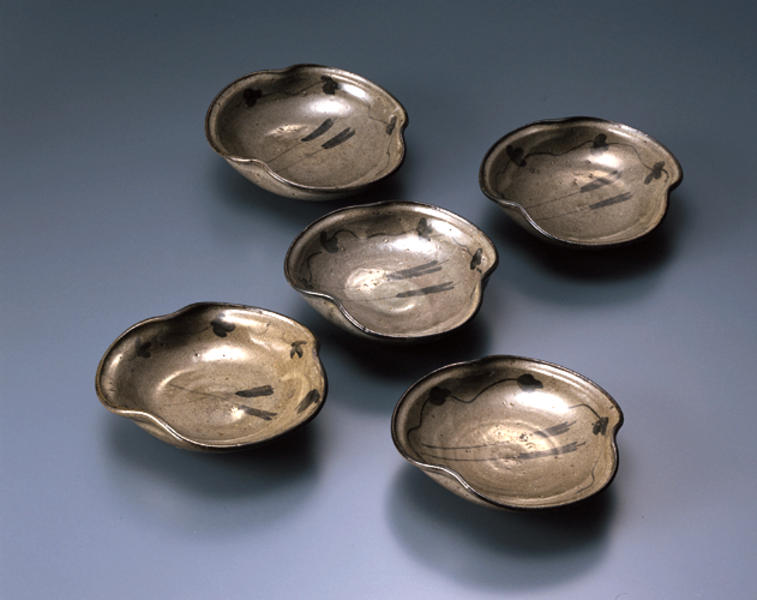絵唐津矢文向付
- 佐賀県・唐津窯
- 桃山~江戸時代
- 17世紀
- 施釉陶製
- H-4.6 D-16
桃山-江戸時代 17世紀
高:4.6cm 口径16.0cm
唐津焼の向付には美濃窯で焼かれた向付に近い作行きのものが数多く見られる。慶長年間に唐津から連房式登窯が美濃の元屋敷に導入されるが,おそらくそれ以前から美濃窯と唐津窯との交流が頻繁であったのであろう。この向付はいわゆる洲浜形に近い平向付で,美濃窯の作にもこうした器形の向付がある。しかし,見込みに描かれている矢文はむしろ唐津独特の意匠のようで,向付に限らず碗などにも見られる。
五客のうち,一客のみ矢が交差した構図であるが,こうした例はほかにもあり,当初より一緒に組まれていたものと思われる。中央の矢文に加えて見込みの縁には唐草文がまわり,また,口端には鉄釉が塗られて口紅とされている。高台は小さく,高台付近には鉄分の多い胎土が見られる。 (赤沼)
唐津焼(からつ)
佐賀県西部から長崎県一帯にかけて焼かれた陶器。窯跡は広範囲に広がっています。開窯時期は天正年間とされていますが、大々的に発展したのは豊臣秀吉による文禄・慶長の役(丁酉倭乱)(ていゆうわらん)で朝鮮の陶工たちが日本に連れてこられて以降のことです。桃山時代の作品は特に茶陶に優品が多く、江戸時代前期までその様式は引き継がれました。
奥高麗茶碗 銘 入舟
瀬戸唐津茶碗
絵唐津水指 銘 十字むしもち
絵唐津筒向付
絵唐津柳文輪花向付
奥高麗水指 銘 明月
唐津大皿
本手瀬戸唐津茶碗 銘 雲井
Catalogue Entry
Set of 5 dishes
Momoyama to Edo periods, 17th century
Karatsu ware, E-garatsu type
Height, 4.6cm; mouth diameter, 16.0cm
There are a considerable number of Karatsu ware mukozuke dishes which were made in a manner very similar to that seen in mukozuke dishes fired at the Mino kilns. During the Keicho period (1596-1615), the consecutive-chamber climbing kiln form used at Karatsu was introduced to the Motoyashiki kilns at Mino, and this fact would indicate that there had been frequent interaction between the Mino kilns and the Karatsu kilns prior to this date. These mukozuke dishes are of the nearly flat mukozuke type known as the "sandy beach" shape, and there were also mukozuke dishes of this shape produced at the Mino kilns. However, the arrow pattern seen in the interior of these dishes is a specifically Karatsu motif and can be found on both mukozuke dishes and other bowl forms.
One dish among these 5 shows crossed arrows as opposed to the parallel arrangement seen on the other four. As there are other examples of this kind of mixed pattern among mukozuke dishes, we can suggest that this group was intended to originally form a set. In addition to the arrow motifs drawn in the center of the interior of each dish, the edges of the dishes are outlined, and the low sides of the interior are decorated with a karakusa vining plant pattern. All decorative motifs have been drawn in underglaze iron. The bottom of the dishes show a small foot, and the iron-rich body clay is exposed and visible near the foot. TA
